Telegram has replaced its open strategy with a closed ecosystem, forcing Mini Apps to migrate to TON, which goes against the spirit of Web3. True decentralization should be about free choice, not forced binding.
Author: @EmanAbio
Translation: Baihua Blockchain
Telegram was once a paradise for developers, allowing anyone to build Mini Apps on their preferred blockchain. But suddenly, they quietly changed the rules: either fully integrate with TON or be completely out. Ironically, TON claims to be "The Open Network," yet it is now blocking other ecosystems.
1. Why am I writing this article?
To make a long story short, @telegram and @tonblockchain's recent actions completely violate the spirit of Web3. For years, @telegram has allowed developers to freely build Mini Apps and connect with almost any blockchain. But overnight, they changed the terms of service, making it clear: "There is no choice but @tonblockchain." No warning, no community discussion, not even room for negotiation.

Developers are under pressure with only a one-month migration period? This means they have to rewrite the entire codebase. Worse still, TON's programming model is completely incompatible with mainstream blockchains like Sui, Ethereum, and Solana. It not only lacks a robust infrastructure but also shows instability when dealing with actual large-scale applications.
In the face of all these challenges, Telegram and TON's compensation is merely a $50,000 grant. @telegram and @ton_blockchain's actions have completely shut developers and users out.
My goal is clear: to expose the hypocritical nature of this so-called "Open Network" and to communicate directly with all affected Sui developers and projects.
For those who are not yet aware of this situation or have only heard bits and pieces but are unclear about the specifics, you might be wondering what exactly happened.
So, let me first tell you the background story.
2. The Development History of Telegram and Mini Apps
Telegram was founded by Pavel Durov in 2013, initially as an instant messaging application focused on security and privacy. Its creation stemmed from the increasing intrusion of governments and corporations into personal data.
Under the dual pressure of political pressure and the need for free communication, Telegram aimed to provide users with a secure and privacy-first alternative, distinguishing itself from mainstream messaging platforms.
People were attracted to Telegram's fast and smooth interface and truly protected encrypted chats, quickly flocking to the platform. But Telegram did not stop at being just a simple chat application.
As the user base grew to hundreds of millions, the platform began to expand its features continuously:
Launched group chats supporting large-scale communities
Opened channel features, allowing information dissemination to cover every corner of the network Most importantly, it released the Bot API, enabling developers to build Mini Apps directly within Telegram, fundamentally changing the platform's ecosystem.
WeChat in China had already proven the powerful potential of Mini Apps, and Telegram quickly responded, issuing its own challenge: "Game on!" Soon, developers from around the world began to flood in, creating various innovative applications: automated ticket booking, gaming centers, quick voting, and even complete business solutions, all seamlessly integrated into the Telegram interface.
This completely changed the game—users no longer needed to leave the app to complete ticket bookings, customer support, or even gaming experiences. All operations were completed within a single chat window.
This wave of momentum was explosive! Games like Hamster Kombat and Notcoin saw player numbers soar to tens of millions or even over a hundred million, proving that these so-called "Mini Apps" could indeed develop into a massive ecosystem.But this was not just a victory for games—brands and startups also rushed into the Mini Apps ecosystem. This combination of "privacy-first + developer-friendly" was the secret weapon that propelled Telegram from an ordinary chat application to a platform with nearly 1 billion monthly active users.
Its open strategy allowed Mini Apps to seamlessly connect with any blockchain or external service, providing a level of freedom and flexibility rarely seen in other messaging software.
—Or rather, this was once the story of Telegram, until they announced an exclusive partnership with TON Blockchain.
So, what exactly is TON? Why did Telegram suddenly push for a single public chain? This is the most worth digging into.
3. The Story of Telegram and TON Blockchain
In 2017-2018, Telegram experienced explosive growth, with user numbers skyrocketing, leaving other platforms in the dust. They had already excelled in secure communication and large group chats, but were still not satisfied and wanted to go further.
Thus, they devised an ambitious plan—to create a brand new Layer-1 blockchain: Telegram Open Network (TON).
What was the vision? To build a super ecosystem capable of supporting billions of messages and transactions, all running within Telegram.
Theoretically, TON would become the core infrastructure of the Telegram ecosystem, supporting payments, decentralized applications (dApps), digital collectibles, and even Mini Apps, completely transforming Telegram into the ultimate gateway to Web3.
On paper, this was a bold layout—a global communications giant fully entering Web3.To realize this vision, Telegram conducted a token sale in early 2018, raising approximately $1.7 billion. Even during the most frenzied times in the crypto market, this was an astonishing figure.
However, the U.S. SEC (Securities and Exchange Commission) quickly intervened, deeming this fundraising to be an unregistered securities offering. Lawsuits followed, and ultimately in 2020, Telegram publicly announced its withdrawal and refunded the funds, "officially" exiting the TON project.

On the surface, the matter seemed to end there. Telegram officially announced it would no longer engage in blockchain, publicly distancing itself from TON and returning to the pure messaging platform track.

Source:
https://t.me/s/durov/156
https://telegra.ph/What-Was-TON-And-Why-It-Is-Over-05-12
Since TON's code is open source, so-called "community developers" took over the project left behind by Telegram and continued to push it forward.Ironically, it was during this phase that developers from other blockchains truly began to delve into Telegram's Mini Apps ecosystem. They viewed Telegram as an open paradise, freely integrating with Ethereum, Solana, Sui, or any public chain that best suited their needs.
No forced binding, no closed ecosystem, only a free sandbox for exploration and experimentation. But Telegram stopping code development does not mean this story ends here. Fast forward a few years, we have arrived at Telegram's exclusive partnership with TON, directly binding all Mini Apps to TON and forcing developers to use a blockchain they "originally had nothing to do with."
4. Telegram's Exclusive Partnership with TON
On January 21, 2025, Telegram officially revealed its hand. From that moment on, all Mini Apps running on Telegram must migrate to the TON blockchain, with no other options. No exceptions, no room for negotiation.
They gave developers one month to comply, with a deadline of February 21, and dangled a $50,000 grant as a "sweetener."
But behind this carrot lies a real big stick. Developers not only have to rewrite code and migrate assets, but also prepare for a series of potential service interruption issues. Otherwise, they risk being kicked off the 1 billion user platform.
This is completely contrary to Telegram's previous open strategy. For years, developers could freely choose to connect with any blockchain like Ethereum, Solana, Sui, etc., enjoying a high degree of ecosystem freedom.
And now, this company that once "abandoned" TON due to regulatory pressure is forcing everyone back into the TON ecosystem.
Doesn't that sound a bit contradictory? It feels like Telegram never really left TON but has been pulling the strings behind the scenes, and now they are finally showing their cards.
The new terms of service read like a "closed garden manifesto": once, developers could choose EVM, Move, or any blockchain that aligned with their vision; now, Telegram's stance is—"Use TON Connect, or please leave." Even more absurdly, none of this was discussed with the developer community. This policy feels more like a stealth patch that caught the entire developer ecosystem off guard.
Developers are forced to find ways to migrate code, restructure entire projects, and shift to an ecosystem that is almost incompatible with mainstream blockchains within just one month.
Even if a rapid migration is technically feasible, $50,000 is far from covering several months of engineering costs, especially when your code relies on features that TON does not support, making the difficulty of migration grow exponentially.
5. The Essence of the Problem: Why Are Telegram and TON Doing This?
A platform that emphasizes freedom and privacy, a blockchain that claims to be an "open network," why suddenly deviate from its principles and take this path of forced closure?
When you step back and see the underlying interests, you'll realize this is not a new trick. In fact, we have seen this kind of play before, haven't we?
1) It's the first time in Web3, but the "walled garden" trick has been seen before
Have you noticed that almost all tech platforms initially wave the flag of openness and freedom, but once they grow large, they quietly tighten up and turn into a closed ecosystem?
Remember Google's "Don't be evil" slogan?
2) Apple once encouraged developers to innovate freely, but later built a "walled garden" with the App Store?
Alright, let's rewind to the late 2000s.
In 2007, the iPhone burst onto the scene, completely revolutionizing the mobile world with its smooth touch experience and unprecedented app ecosystem.
In 2008, Apple launched the App Store, which was initially a paradise for developers—
Pay a $99 fee, and you can list your app
Directly reach a growing pool of iPhone users, with huge market potential This was a revolutionary innovation, but it planted the seeds for what was to come—Apple took a 30% cut from every sale or in-app purchase.
At that time, most developers didn't pay much attention to it. A 30% cut was indeed high, but compared to building their own distribution channels? Almost impossible. This was the early stage of Apple's "walled garden."Meanwhile, Google saw Apple’s success and quickly launched the Android Market (now Google Play Store). They offered developers a similar 70/30 revenue share model while promoting "openness," claiming that Android was more flexible than iOS. Initially, both platforms loudly proclaimed themselves as havens for developers—anyone could easily develop apps, whether games, tools, or productivity software, with low barriers to entry. But soon, cracks began to show…  Apple insisted on a strict app review process, sometimes rejecting certain apps under ambiguous "quality issues." Google, initially more lenient, soon began tightening its rules as well. Over time, both platforms **constantly adjusted policies, gradually increasing control**— * **Restricting specific categories of apps** (for example, early cryptocurrency apps were often removed) * **Forcing all in-app payments to use the official payment system**, banning third-party payment channels **It was at this point that developers began to realize that the so-called "openness" was gradually turning into "closure."**  This conflict erupted in the **Epic Games vs. Apple** lawsuit: Epic directly stated, "**We refuse to pay you a 30% cut!**" Apple's response was, "**Then you can forget about being listed on the App Store.**"Even when Epic later attempted to compromise and seek a settlement, Apple still blacklisted them, maintaining a hardline stance. Apple was essentially saying, "**Sorry, Fortnite wants to return to iOS? Let's talk after all appeals are settled.**" Even when Epic raised the white flag, Apple kept the door firmly shut, effectively blocking Fortnite and its massive user base from the iOS ecosystem indefinitely. 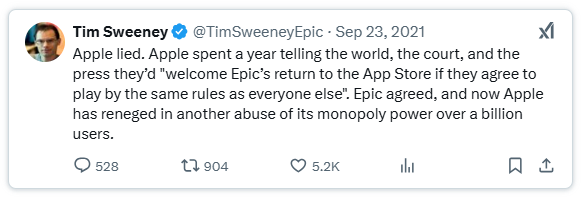 Similar controversies also stirred in South Korea. Local legislative bodies forced Google and Apple to allow alternative payment solutions, directly challenging their closed ecosystems. Meanwhile, user communities began to question data portability, open standards, and the trend of "everything you do on your phone being controlled by the platform." Although Apple and Google later made some minor concessions, such as reducing the cut on the first $1 million in revenue to 15%, their overall business model remained unshaken. Ultimately, developers realized: **If they want to achieve scale on iOS or Android, they must play by their rules.** #### 3) **The same script, different stage, now it's Telegram's turn** Now, this scene is playing out on Telegram, where they have replicated the same trick with TON. Essentially, Telegram and TON are doing this for a very simple motive: to control users & generate revenue. Once platforms realize the value of data and traffic, their control will only tighten further.
Reflecting back, Telegram announced the TON blockchain as early as 2018, intending to make TON the core of its ecosystem, but was directly stifled by regulatory authorities. They paid fines and withdrew from the project… but now, this play is being reenacted.
The difference is that this time Telegram has directly bound all Mini Apps to TON, forcing developers to use this chain. Why now?
- The regulatory environment has loosened somewhat compared to 2018, giving them more operational space.
- Telegram remains the most important communication platform in the Web3 space, holding massive user traffic.
- Exclusively binding TON and forcing all Mini Apps to migrate ensures that all on-chain activities, fees, and user interactions are captured by the TON ecosystem—this is not a coincidence, but a thorough traffic harvest.
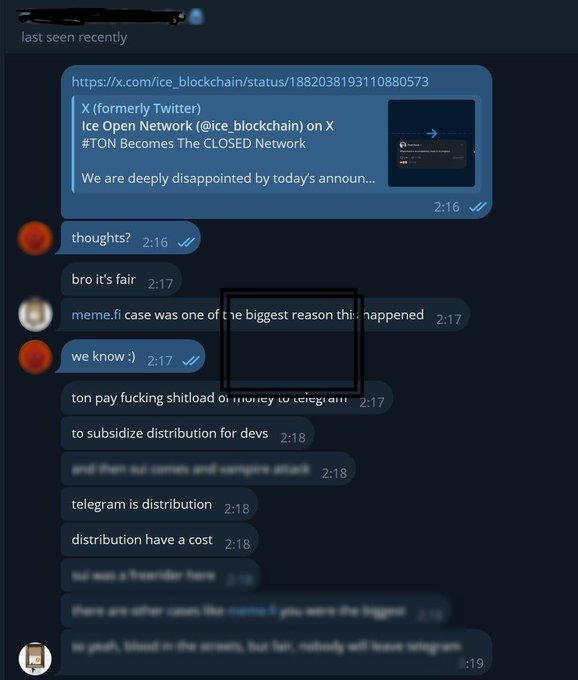
If Telegram simply announced: "We are reintroducing TON to compete fairly with other blockchains, allowing developers to choose freely." then it would be considered a fair market game. But that is not the case; they chose to directly lock down the ecosystem, giving developers a very short migration deadline and providing funding that barely covers migration costs.
Does this strategy sound familiar? - First, attract developers with a massive user base, making them excited about "direct access to hundreds of millions of users."
- Once everyone is invested, suddenly change the rules, issuing an ultimatum: "From now on, you can only use our chain." This is the old trick of Web2, and now Web3 is starting to play it too.
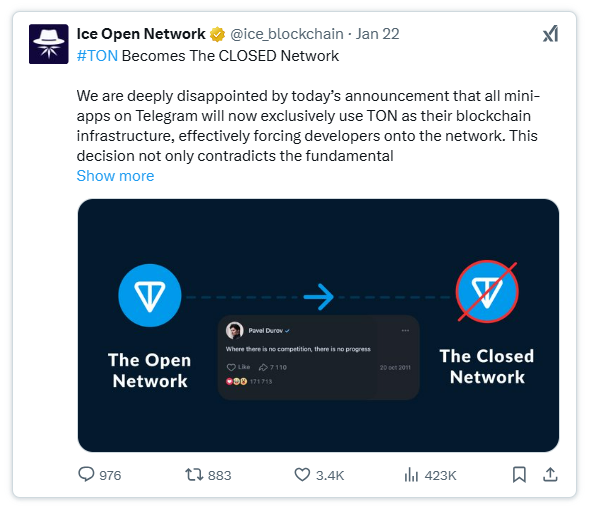
4) Once Telegram builds a "walled garden," a huge red alert goes off
If TON is truly powerful, why does it need to use "coercive means" to attract developers instead of relying on market natural selection?
If TON possesses the strength of a top public chain: complete development tools; high-performance network; thriving ecosystem, then Telegram could allow the market to compete freely, and developers would naturally choose the optimal solution. **But the reality is that developers who have truly tested TON say that this chain has not even laid a solid foundation—performance, **compatibility, infrastructure, all lag behind mainstream blockchains.
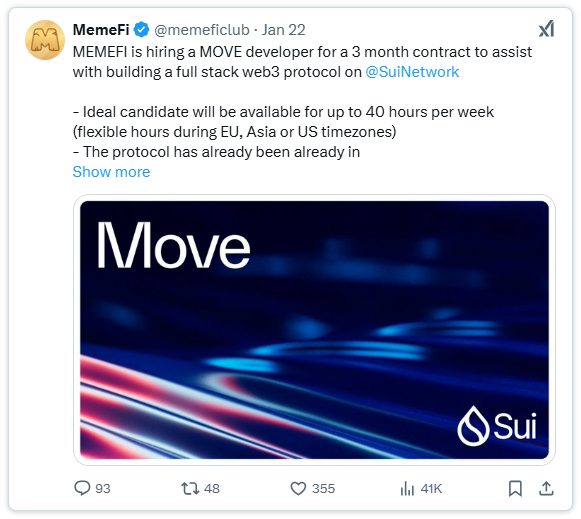
This is precisely why Mini Apps like @memeficlub, @TheBirdsDogs, and @WaveOnSui, which have achieved great success on Telegram with millions of daily active users (DAU), still firmly choose @SuiNetwork over @ton_blockchain.
If TON were truly excellent, developers would have migrated voluntarily long ago, without needing Telegram to set up closed rules.

The fact is, forced binding cannot turn a fundamentally unstable chain into the next Sui.
5) You cannot forcibly shove 1 billion users into a weak blockchain
If you ask engineers who have genuinely tried to develop on TON, they will tell you: the development experience on this chain is far from "smooth." The biggest problem with TON is that it is not a "developer-friendly" powerful tool at all. Developers who have truly tried it repeatedly emphasize—TON cannot compete with modern public chains because it lacks: a mature DeFi ecosystem; robust infrastructure; high-load scalability.
In other words, TON claims to be the "future blockchain," but what developers face is—
- A strangely designed programming model with a high learning curve.
- Incompatibility with any mainstream blockchain.
- Scarcity of development tools, lacking comprehensive ecosystem support.
This is a disaster for developers accustomed to Sui or Solana. On these mainstream chains, toolchains, documentation, and community support are already mature and complete, while on TON, developers can only feel their way across the river, facing a host of strange restrictions. Then, there is an even more serious issue—scalability.
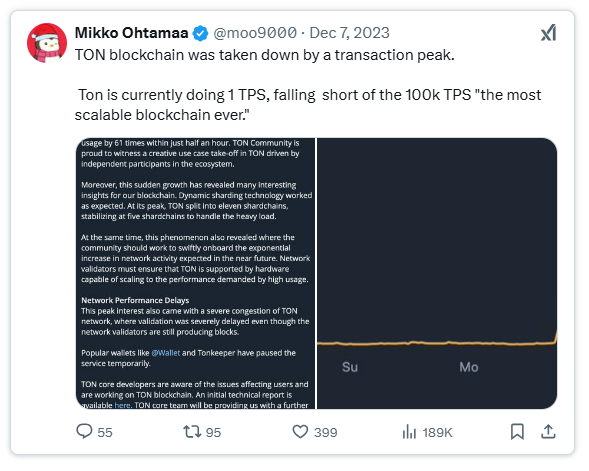
6) TON boasts high performance, but developers who have truly conducted stress tests do not see it that way
Ask those who have conducted stress tests on TON, and they will tell you: TON cannot hold up under high-load conditions. Some developers even recall that certain Mini Apps crashed the chain as soon as they went live. Whenever there are negative cases of "some public chains can't handle even a few thousand concurrent users," developers are more inclined to avoid that chain. After all, if you are building a Mini App on Telegram aimed at millions of users, you cannot afford the risk of the chain collapsing directly.
A bigger problem: the TON ecosystem is severely lacking. Building a truly usable dApp is far more than just deploying a smart contract. You also need:
- Liquidity pools for token exchanges.
- NFT marketplaces for asset circulation.
- Lending protocols to provide financial derivative support.
- Data indexers for easy querying and analysis of on-chain information.
- DeFi aggregation tools to optimize yield strategies.
In other words, a mature Web3 ecosystem relies on a strong "Lego-style" infrastructure that allows developers to freely combine various functions. But TON's construction in these areas is far behind, which directly limits the innovation space for developers. This is precisely why @memeficlub, @TheBirdsDogs, and @WaveOnSui ultimately chose Sui over TON.
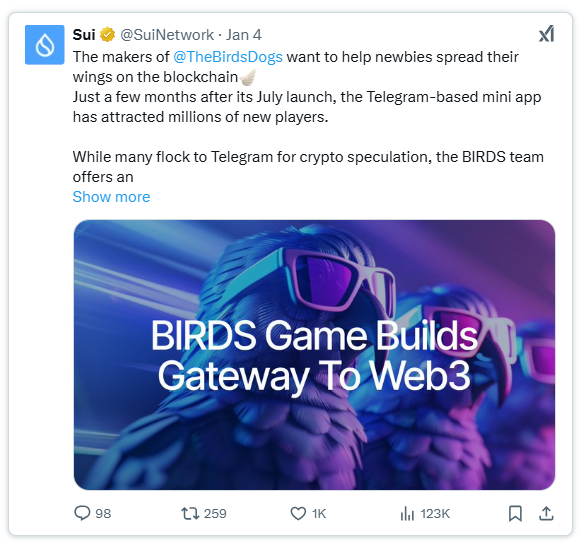
7) The Sui ecosystem is mature, while TON is far from being formed
The Sui ecosystem already has a complete infrastructure, with comprehensive developer tools that allow project teams to quickly build and seamlessly integrate, easily piecing together the required functions. And what about TON? The ecosystem is still quite barren. Yes, there are indeed some Telegram bots and sporadic experimental projects, but compared to mainstream blockchains, TON lacks truly deep DeFi facilities:
- No mature DEX (decentralized exchange), limited liquidity
- Lack of comprehensive lending protocols, severely insufficient financial products
- NFT market development is slow, making it difficult to achieve scale. With an incomplete ecosystem, developers can only rebuild infrastructure from scratch or awkwardly adapt some incomplete integration solutions. In contrast, mature public chains like Sui have already paved the way for success, allowing developers to ride the wave and directly enjoy the ecological benefits.
8) Forced binding to TON? Developers vote with their feet
With Telegram's "TON Only" closed strategy, developers are forced to take sides, and the market's reaction is already quite clear—they are looking for better options. Any developer who has experienced how Web2 giants (Apple, Google) close their ecosystems can foresee the upcoming trend: If you compromise with Telegram's current move, you are giving them a green light; in the future, they will tighten their grip even more.
6. The open spirit pursued by Web3 is being eroded
Those who truly understand the spirit of Web3 should see the reality: Give Telegram an inch today, and tomorrow they will want a whole road.
1) Web3 does not need "walled gardens"
The most exciting aspect of Web3 lies in open collaboration, shared standards, and permissionless innovation. In a truly decentralized world, you do not force developers to use only your chain, but rather compete freely based on technology, user experience, and ecosystem strength. If a blockchain cannot attract developers through its own advantages—
✅ Faster transaction speeds
✅ Stronger DeFi ecosystem
✅ More complete development tools
Then, it is already at a disadvantage. Forced binding will ultimately harm the ecosystem. Using the method of "must migrate to my blockchain, or leave" will only:
❌ Drive away the best developers
❌ Stifle the creativity of the Web3 ecosystem
This is in direct contradiction to the ideals of openness, freedom, and decentralization that Web3 pursues.
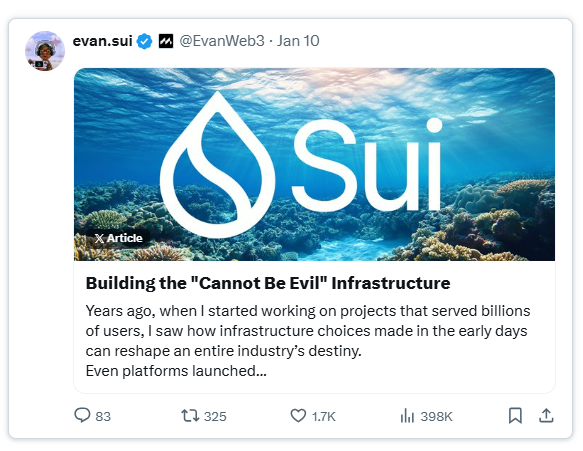
The core of Web3 is not about forcing developers to be trapped in a closed ecosystem, but about empowering them by providing:
✅ Better performance
✅ Greater composability
✅ True user ownership
This is the future we have been striving for since the birth of blockchain—a world where everyone can freely build and share value, without being manipulated by centralized platforms.
2) Telegram and TON still have a chance to turn back
@telegram and @ton_blockchain can still retract this closed decision and truly embrace the open, fair, and decentralized ideals of Web3. Short-term exclusivity may bring profits, but in the long run, only a truly open ecosystem can thrive. Developers should freely choose the most suitable chain, rather than being forcibly bound. Meanwhile, platforms like @SuiNetwork will continue to welcome innovators and push the boundaries of on-chain performance, regardless of how Telegram ultimately decides, the true spirit of Web3 will continue.
If Web3 represents opportunity, creativity, and transparent competition, then forcibly locking developers is not only unpopular but also unsustainable.
Article link: https://www.hellobtc.com/kp/du/02/5663.html
Source: https://x.com/EmanAbio/status/1887603924141826556
免责声明:本文章仅代表作者个人观点,不代表本平台的立场和观点。本文章仅供信息分享,不构成对任何人的任何投资建议。用户与作者之间的任何争议,与本平台无关。如网页中刊载的文章或图片涉及侵权,请提供相关的权利证明和身份证明发送邮件到support@aicoin.com,本平台相关工作人员将会进行核查。



